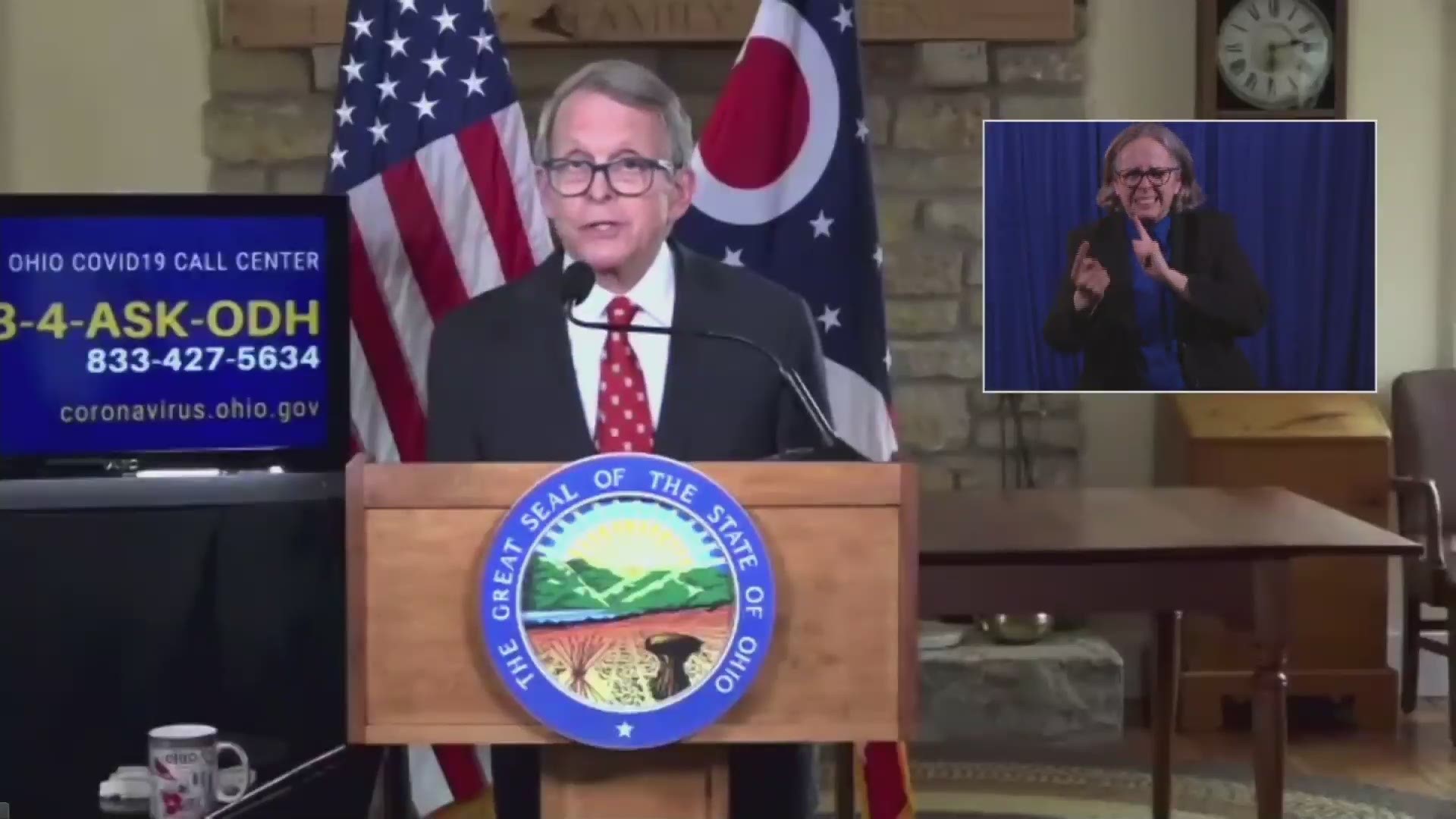COLUMBUS, Ohio — Monday marked Day 1 of vaccinations for Ohioans 50 and older, as well as those with Type 2 diabetes and end-stage renal disease.
DeWine said Thursday announcements regarding the next phases of vaccination will likely not come for another few days.
He said that the state has been going primarily by age, as the state has found it to be the best indicator for developing complications of the disease. DeWine noted that about 98% of Ohio's coronavirus deaths have occurred in the current eligible age group of 50 and above.
However, as phases 1D and 2B began Thursday, DeWine painted a hopeful picture for the future, announcing several changes to state guidance as we move toward the warmer months.
Here is a breakdown of what was discussed during Thursday's briefing.
COUNTY FAIRS
DeWine said Thursday that he expects the state will be able to have full county fairs in 2021, noting that if things continue to go well, all health orders could already be off by the time things get going in June.
Official guidance is expected to be released Thursday evening.
HIGH SCHOOL SPORTS
The governor also announced an update to school sports guidance during his latest briefing.
Students who are not required to quarantine because they have had incidental exposure to COVID-19 in a classroom can participate in sports activities as long as they don’t have symptoms and follow the appropriate sports guidance.
In Dec., DeWine announced that the state was no longer recommending that classmates of K-12 students who test positive for the coronavirus quarantine, so long as the students were wearing masks and only in the classroom with the positive student.
When that recommendation was first announced, it didn't apply to sports and other extra-curriculars.
"The good news is spring sports is outside, which makes things better. And we're also seeing better numbers," DeWine said. "So we're announcing today that students are not required to quarantine because they've had incidental exposure to COVID in a classroom."
NURSING HOMES
The federal government announced this week new guidance regarding nursing home visitation.
DeWine said that the Centers for Medicare and Medicaid Services are now advising that facilities should allow responsible indoor visitation for all residents, regardless of the vaccination status of the resident or visitor.
For more on that guidance, click here.
Ohio Department of Aging Director Ursel McElroy said that there are a few exceptions to this allowance, including:
- Unvaccinated residents when the nursing home's county positivity rate is above 10% and less than 70% of the residents in that nursing home are unvaccinated.
- Residents with confirmed COVID-19 infection, whether vaccinated or unvaccinated.
- Residents in quarantine, whether vaccinated or unvaccinated.
For facilities as a whole, here's the guidance for when to allow and for when to consider suspending in-person visitation following a confirmed COVID-19 case:
- If the first round of outbreak testing reveals no additional COVID-19 cases in other areas of the facility, visitation can resume for residents in areas without COVID-19.
- If the first round of outbreak testing reveals one or more additional cases in other areas of the facility, visitation should be suspended for all residents.
For more information, check out the Ohio Department of Aging website here.
McElroy said that no matter what the situation, however, compassionate care visitation is always allowed. If you believe you are being denied this type of visitation with a loved one, reach out to 1-800-282-1206.
Residents and employees at nursing homes can continue to get vaccinated, DeWine said.
In terms of assisted living facilities, DeWine said the guidance will be changed in the state to allow in-person visitation within the residents' rooms. Those changes can be expected in the coming days, he said.
RAPID TESTING
As more Ohioans get their COVID-19 shot, DeWine said there is still a reliance on the basics, like testing.
DeWine announced four key initiatives Thursday that are focused in making rapid COVID-19 tests more accessible in the state.
Since Dec., he said, the state has provided federally-qualified health centers with more than 150,000 rapid tests that are administered on-site.
His team is working with local health departments to figure out how to use them to address local priorities, as well as public libraries to make at-home tests available in more Ohio communities.
During the first two weeks of this initiative, DeWine said, the state has had nearly 120 library systems say they want to partner on the effort.
DeWine also announced that rapid testing will soon be available in K-12 schools in an effort to increase confidence and safety in the state's schools.
"Soon we'll be shipping more than 200,000 of the at-home tests to our Educational Service Centers, and I encourage our school districts to take advantage of the resource," he said.
COVID-19 DATA
DeWine said that when the state hits 50 cases per 100,000 people over a two-week period, all public health orders would be dropped.
On Thursday, he said Ohio was at 155 cases per 100,000 people - a drop from last week when the number stood just below 180.
"That is great progress," DeWine said.
For comparison, at its peak on Dec. 16, 2020, that number was at 845.5 cases per 100,000 people.

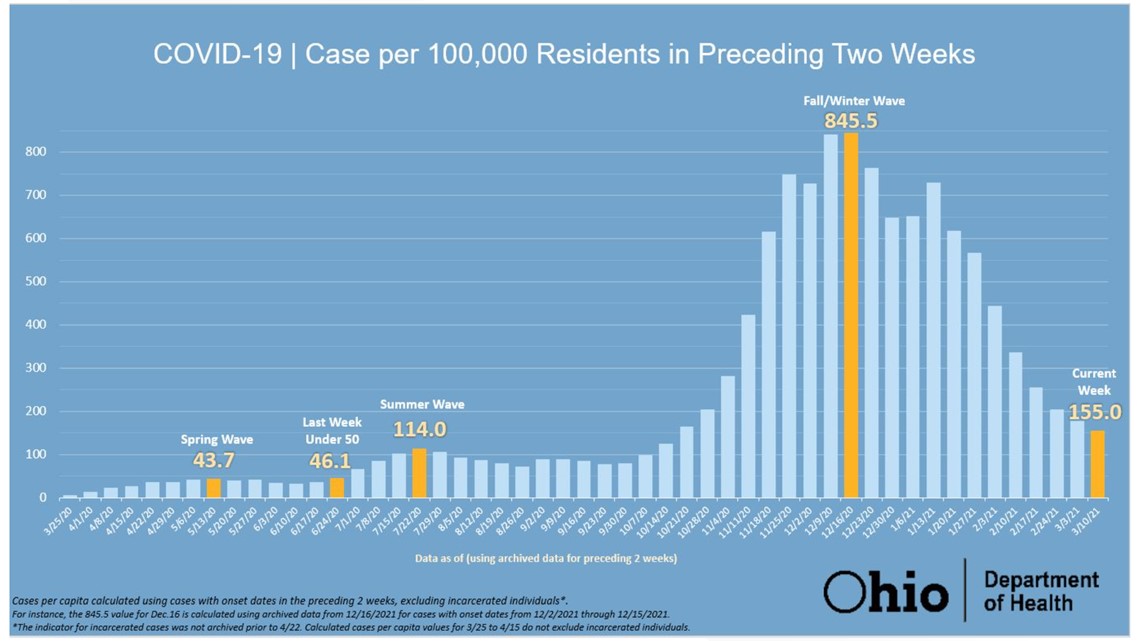
The Ohio Department of Health released its daily data during DeWine's presser compared to each metric's 21-day average:
- 1,448 new coronavirus cases compared to the 21-day average of 1,788
- 112 new coronavirus hospitalizations compared to the 21-day average of 108
- 10 new ICU admissions compared to the 21-day average of 12

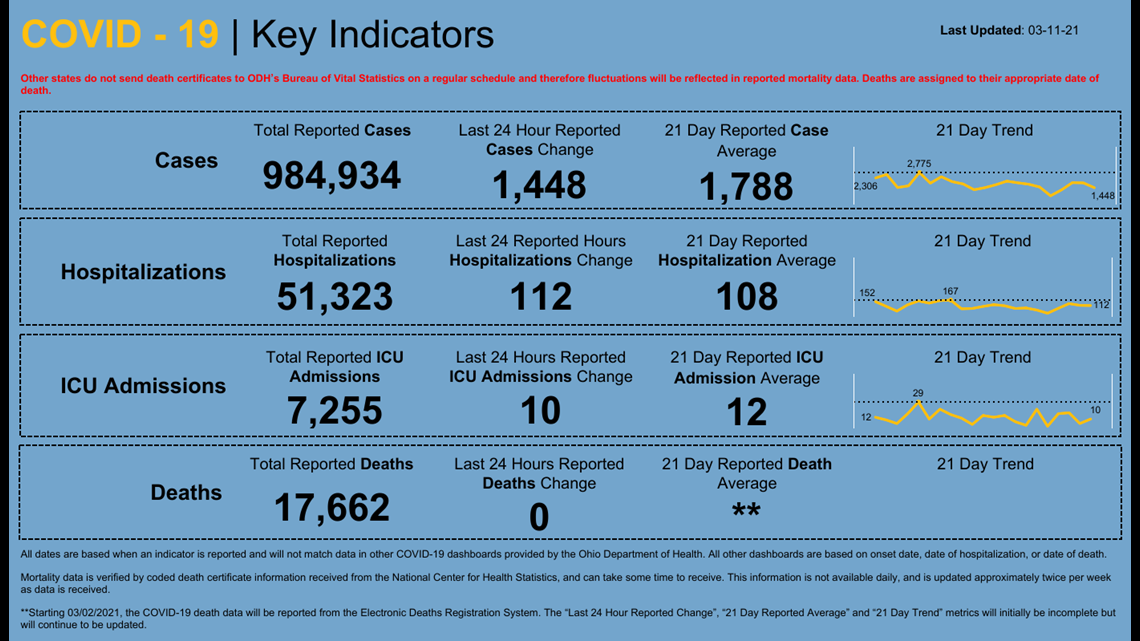
MONDAY
Ohio Gov. Mike DeWine announced expanded vaccine eligibility during his Monday coronavirus briefing, introducing Phase 1D and Phase 2B.
From who can get the vaccine to how to make an appointment, here is a breakdown of what was discussed during DeWine's latest coronavirus update.
EXPANDED ELIGIBILITY
Although Phase 1C and Phase 2 just kicked off on Thursday of last week, DeWine has expanded COVID-19 vaccine eligibility in the state once again.
Starting Thursday, March 11, the following medical conditions will qualify under what DeWine is calling Phase 1D:
- Type 2 diabetes
- End-stage renal disease
Phase 2B, which will also begin Thursday, March 11, lowers the age requirement for the vaccine to those 50 and older.
RELATED: DeWine lays out criteria for removing all COVID-19 restrictions in Ohio during Thursday address
CENTRALIZED SCHEDULING SYSTEM
And as more people begin qualifying for the vaccine, an easier way to make an appointment is now available in the state, as the Ohio Department of Health's centralized scheduling system is finally online.
Ohioans can access the portal online by clicking here.
The new tool can be used to help residents figure out whether or not they are eligible to receive the vaccine, schedule an appointment as well as sign up for updates and reminders.
As of Monday morning, DeWine said, there were thousands of appointments available, and more slots will be added every day.
Providers are required by the state to either schedule appointments through this new system or by using another electronic scheduling system that works with the state's portal.
DeWine said he thinks the state's new centralized system will help streamline the scheduling process, reduce data lags and provide real-time information.
The tool will also be used to make appointments for the mass vaccination clinics that will be set up throughout the state by the end of the month. One of those long-term sites will be located at the Lucas County Recreation Center, DeWine announced last week.
COVID-19 DATA
On Monday, the Ohio Department of Health reported:
- 1,254 new cases of coronavirus compared to the 21-day average of 1,831
- 84 new coronavirus hospitalizations compared to the 21-day average of 111
- 15 new coronavirus ICU admissions compared to the 21-day average of 14
Death data will no longer be available daily, a note read on the state website. Rather, newly reported COVID-19 deaths will be announced twice per week, as data is received.

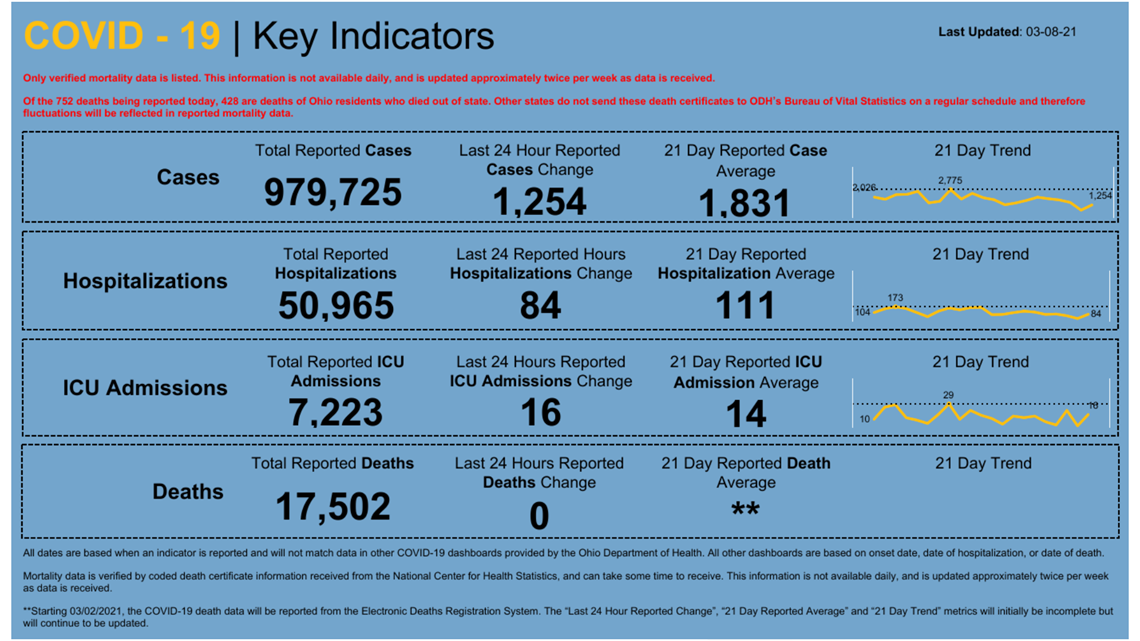
Hospitalizations in the state have continued on a downward trend.
On Monday, Ohio had a total of 830 COVID-19 positive patients. Roughly two weeks ago, on Feb. 23, there were 1,358.

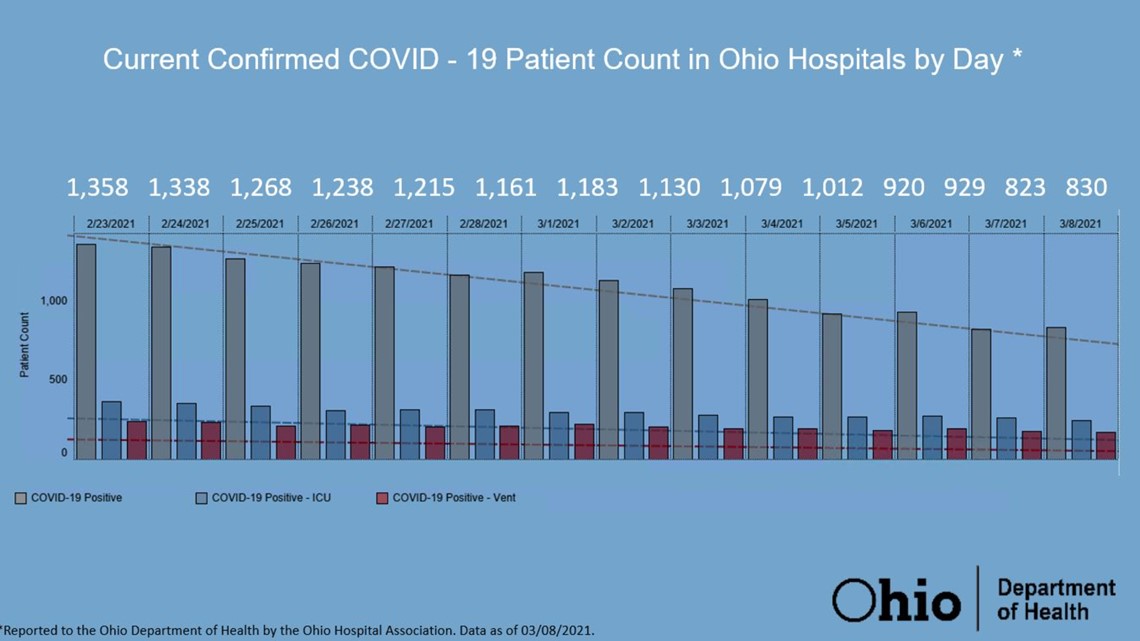
ANNIVERSARY OF FIRST COVID-19 CASE IN OHIO
To recognize the one-year anniversary of the first recorded COVID-19 case in the state, DeWine ordered all U.S. and Ohio flags be flown at half-staff upon all public buildings and grounds from sunrise to sunset this Tuesday, March 9.
BGSU HAZING
Though not related to the virus, DeWine addressed the alleged hazing incident at Bowling Green State University, resulting in the death of 20-year-old student Stone Foltz.
DeWine released this statement:
"Ohio mourns the death of student Stone Foltz, who died as a result of alleged hazing. His tragic and senseless death should remind us all of the moral imperative for us to drive hazing out of this state.
I talked a few minutes ago to State Senator Stephanie Kunze, who has been working on a bill to reform and improve our laws in this area. I support her efforts.
Let us resolve that Ohio will become a hazing-free state. Tomorrow I will be talking with all our state university presidents about this issue."

